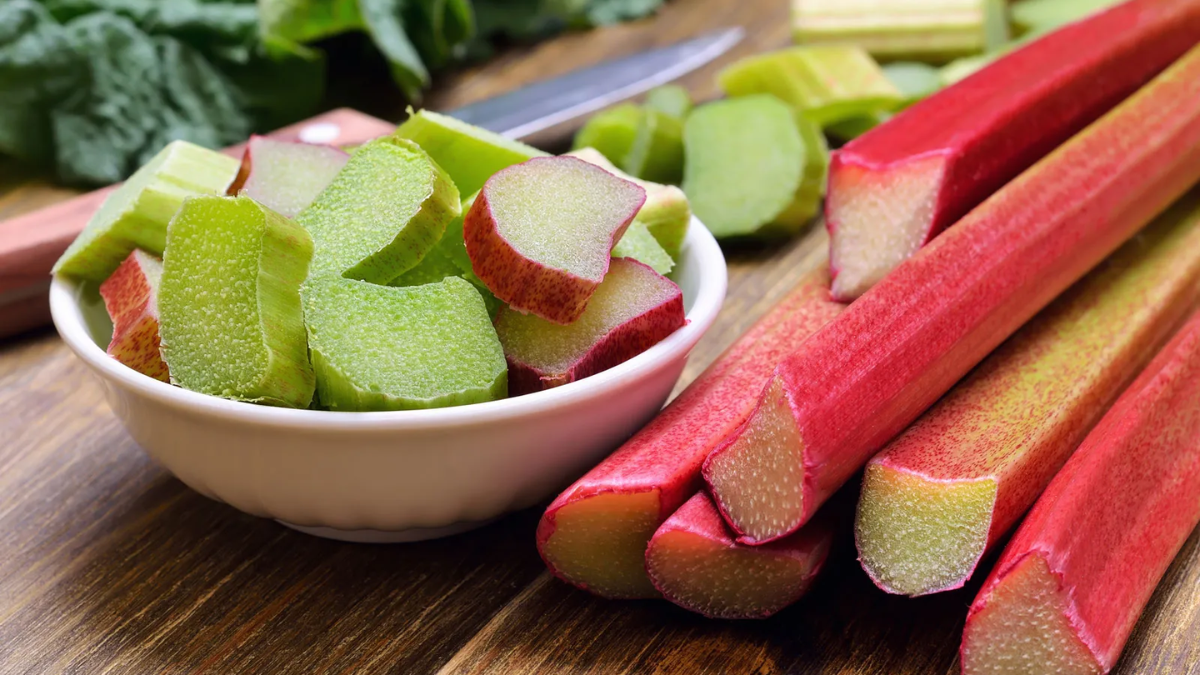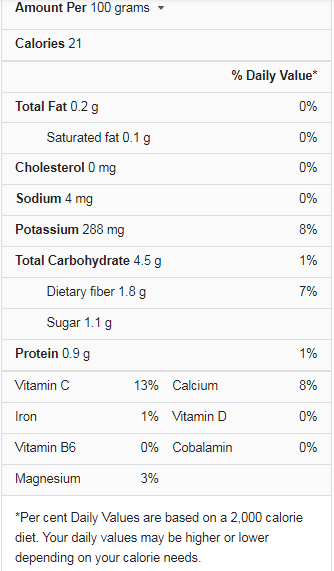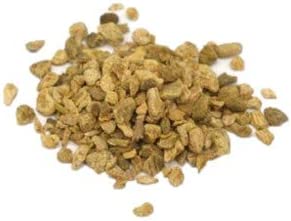Rhubarb is a vegetable that many people treat like fruit while cooking and creating recipes (its scientific name is Rheum rhabarbarum). Despite being an Asian native, it grows worldwide, including in the U.S. The springtime growth of the long red leafstalks reaches its climax in mid-April. The plant doesn’t do well in the heat, so it prefers cooler climates. Only the plant’s stalks can be eaten.
High levels of oxalic acid and toxins are present in the leaves. The stalks are themselves meaty, acidic, and sour. Even though you can eat them raw, most people choose them cooked. The use of rhubarb dates back to ancient Chinese medicine. Ancient Arab, Greek, and Roman civilizations also employed it. It is now widely used in jams, pies, compotes, and beverages.
What is Rhubarb?
Rhubarb is an abundant and early springtime “fruit” that resembles pinkish green or even magenta celery stalks. Because of its considerably tarter flavor, it pairs well with sugar in desserts like pies, crisps, and compotes (from which it gets its second name, “pie plant”). Additionally, rhubarb gives savory recipes a puckery-tart fruitiness and goes great with pork and fowl. Rhubarb is cultivated throughout the world, particularly in China and Europe. The northern states of the United States, extending from Maine south through Illinois and west to Washington state, are where rhubarb grows best.
A plant belonging to the Rheum genus is rhubarb. Despite being a tough perennial vegetable, it functions more like a fruit. The U.S. Department of Agriculture (USDA) formally recognizes it as a fruit, and a New York customs court judge determined as much in 1947. The plant is well-liked and simple to grow in backyard gardens (even difficult to get rid of when you want to). It grows its recognizable vividly colored stalks, which range from red to pink to pale green, in the spring and needs a cold winter to thrive.
Rhubarb Nutrition Facts
Health Benefits of Rhubarb
Rhubarb contains vitamin A, which may aid in protecting your skin from free radicals that damage it and promote premature aging by fighting them. It contains many essential vitamins and minerals, antioxidants, and health advantages. Vitamin K, which is necessary for blood clotting and bone health, is abundant in rhubarb.
Boost Individual Health
Rhubarb’s vitamin K content aids in maintaining strong, healthy bones. Vitamin K is crucial for developing new bone and helps guard against osteoporosis.
Save your Heart and Health
Fiber lowers cholesterol, and rhubarb is a great source of it. Studies show that rhubarb can help lower your total and bad cholesterol levels. Your risk of heart disease and a heart attack decreases with lower cholesterol levels. Rhubarb contains vitamin K, which may help prevent blood vessel calcification. The anti-inflammatory properties of the vegetable’s antioxidants also safeguard your heart’s health.
Digestive Aid
Rhubarb’s fiber keeps things flowing through your digestive system, avoiding issues like constipation. Sennosides, a class of chemicals found in it, are also natural laxatives. Additionally, rhubarb’s tannins have anti-diarrheal properties.
Avoid Cancer
Due to the antioxidants in rhubarb, the body can better combat free radicals, which may help prevent oxidative stress and cell damage. Antioxidants’ ability to combat free radicals may lower your risk of getting some cancers.
Limit Inflammation
Rhubarb’s antioxidant components aid in the reduction of inflammation. People who suffer from systemic inflammatory response syndrome may benefit from these qualities. Another study discovered that rhubarb extract’s anti-inflammatory qualities could facilitate faster-wound healing.
Could Reduce Cholesterol Levels
Fiber from rhubarb stalks is a healthy source and may lower cholesterol. Men with high levels consumed 27 grams of rhubarb-stalk fiber daily for a month in one controlled research. Their LDL (bad) cholesterol decreased by 9%, while their total cholesterol fell by 8%. This good result is not unique to rhubarb fiber. Numerous other sources of fiber are also efficient.
Antioxidants are Provided
Additionally, rhubarb is a great source of antioxidants. According to one study, it may have a total polyphenol level even higher than kale. Anthocyanins, which give rhubarb its red color and are believed to have health advantages, are among the antioxidants found in this plant. Proanthocyanidins, commonly referred to as condensed tannins, are abundant in rhubarb. Some health advantages of fruits, red wine, and cocoa may be attributed to these antioxidants.
How to Eat Rhubarb?
When the vegetable is in season, which is normally from April to June, you might be able to locate fresh rhubarb in the produce area of your local grocery store.
Look for firm, crisp stalks when selecting rhubarb. Avoid ones that have flaws or are limp. A younger plant will have smaller leaves, so keep an eye out for those. Remove the leaves before cooking or eating.
To prevent the rhubarb from drying out, wait to trim the stalks until you’re ready to utilize it. Place full stalks in a tight plastic bag and keep them in the fridge. Within a week, use them. Cut your rhubarb into pieces and put them in the freezer until you’re ready to use them if you want to preserve them for later use.
Rhubarb can be consumed in various ways, such as raw, cooked into jam, or mixed into a smoothie. These are some additional ways to eat the vegetable:
- Baking it to make a crumble or pie
- Making ice cream with rhubarb
- fresh juices or homebrewed kombucha with rhubarb
- incorporating it into a sauce for chicken or beef
- Using a puree and a dehydrator to create rhubarb leather
- putting roasted rhubarb in a salad after being drizzled with honey
How to Cook with Rhubarb?
Rhubarb is simple to cook. The leaves must be trimmed and thrown away due to their toxicity. Trim the dry ends as well after thoroughly washing the stalks. Avoid the urge to peel the fibrous skin as you slice the stalks. The skin is colorful and flavorful.
When rhubarb is cooked, two things happen: its juices thicken and crumble into frayed shreds of fine fibers. For rhubarb jam, chutneys, and compotes, heavily cooked rhubarb provides the ideal jellied consistency. When arranged on a pie or stir-fried, it is less appealing. Quick heat produces rhubarb pieces that are cohesive but tender, have a deep flavor, and have a natural, glossy shine.
Varieties
There are numerous rhubarb cultivars, some of which have unexpectedly pleasant green stalks. Markets and larger grocery shops often carry two primary varieties of rhubarb: the older, more traditional version with thicker, greener stalks and the more vividly colored, slender-stalked variety, also known as hothouse rhubarb. The dark red stalks give meals a brighter, more appealing appearance, but the concentrated hue denotes a sharper tartness. The flavor of the greener stalks is well-balanced and pleasant.
Storage Tip
Trimmed stalks should be kept in the refrigerator’s crisper drawer for about a week in loose plastic. Many chefs like to wash the rhubarb only before using it, but if you do so before storage, make sure it has completely dried. Cut the rhubarb stalks into 1-inch chunks, then place them in an airtight bag to freeze. At 0 F, frozen rhubarb can last up to a year.
Where to Buy Rhubarb?
While field-grown stalks are available in the early spring, typically from April through June, hothouse rhubarb is available most of the year. The Pacific Northwest is fortunate to have a second rhubarb crop in June and July. It would help if you savored it when you see it because the growing season is brief. Both farmer’s markets and grocery stores frequently have it in stock.
Typically, it is sold loose by the stalks. The stalks, which are sold by the pound, are the size of enormous individual celery stalks. If a farmer has a bumper crop or a very strong growing season, they may sell rhubarb in bulk. The stalks should have firm, lustrous skin and be hefty and crisp, regardless of hue. Avoid stalks that are dry, fibrous, and rubbery.
A home garden can be used to raise and harvest rhubarb. Don’t harvest the plant the first year; let it alone. You can take a modest harvest in the second year, and by the third year, you can harvest the entire crop. Only the stalks that are at least an inch thick should be harvested. Cut the stalks at the soil level or remove individual stalks as needed to harvest. You can harvest the entire crop at once or in stages over four to six weeks. Unless illnesses or pests harm them, plants can continue to produce for eight to fifteen years.
What does Rhubarb Taste Like?
Is Rhubarb Good for Weight Loss?
The same substances that give green tea its health benefits, catechins, are also present in it. The ability of catechins to increase metabolism is recognized to promote fat burning and weight loss. Another vitamin crucial for weight loss, fiber, is present in rhubarb and is a good source. In some regions, rhubarb stalks are a common snack. They also contain a lot of vitamin K. Because they contain only around 1 gram of natural sugar per cup, they’re a decent option if you’re trying to control the quantity of sugar in your diet.
Dip the stem into sugar or honey to lessen the sour flavor of rhubarb when eating it alone. Make a quick batch of raw rhubarb compote and serve it with your homemade yogurt in the morning. Its sharp acidity pairs perfectly with coconut, mangoes, and even sweet, ripe strawberries (of course). There isn’t enough credible scientific data to support the majority of the ways people take rhubarb, including for diarrhea, stomach pain, indigestion, menopause symptoms, menstrual cramps, obesity, pancreatic enlargement, and a host of other problems.
Conclusion
The rhubarb plant’s huge, triangular leaves are poisonous. Therefore, only the stalks are consumed. They have more oxalic acid than vegetables like spinach, broccoli, and cauliflower (which have perfectly safe levels). It’s also believed that rhubarb leaves contain a worse poison that hasn’t been found yet. Even a small amount of the leaves may cause nausea and vomiting, and consuming large quantities is likely fatal. Keep the leaves away from children and pets, and refrain from eating or serving them. After removing the leaves, the rhubarb only needs to be sliced and trimmed to your preferences. In general, rhubarb costs per pound and is sold by the pound.
Usually, the price depends on what is produced throughout the season’s crop. Some chard varieties, particularly ruby red chard, which occasionally comes bundled with rainbow chard and has red stems, could initially be mistaken for rhubarb. However, there are key distinctions between the two. First, chard is a member of the beet family despite not being a root vegetable. While both plants’ stalks can be consumed, only the chard leaves are edible. Comparing the two plants side by side reveals that chard has more noticeable veins and uniformly colored leaves. Rhubarb often has veins that coincide with leaf veins but vary by variety.




